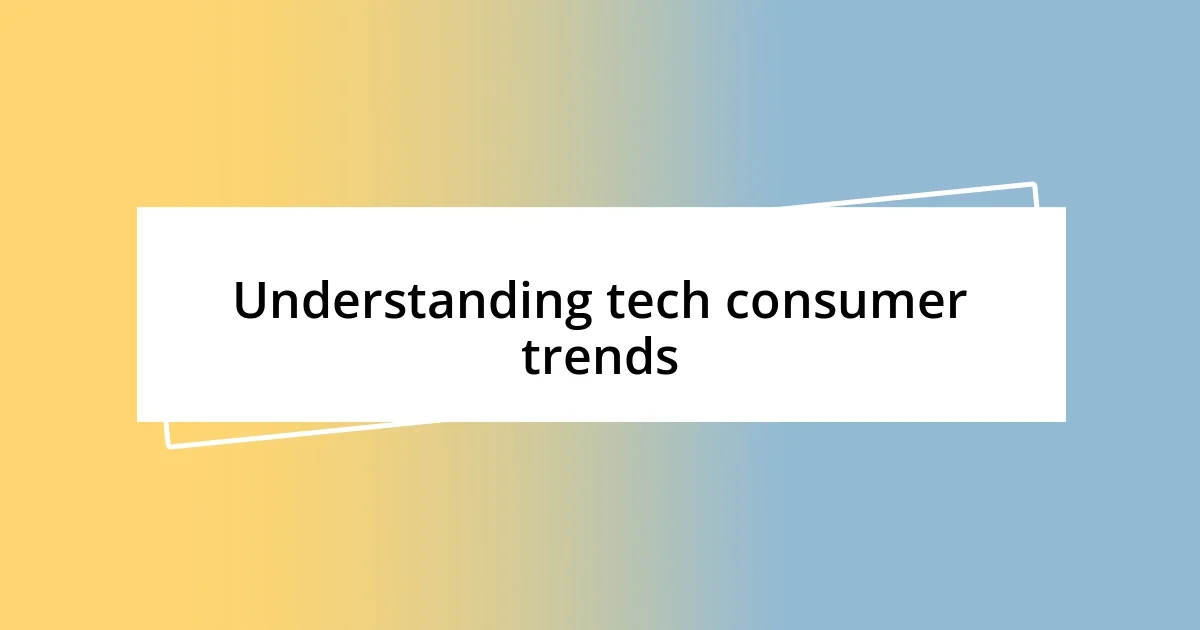Key takeaways:
- Consumers increasingly prioritize brand values, emotional connections, and peer recommendations in their buying decisions.
- Factors like brand reputation, pricing strategies, and user experience significantly influence tech purchase choices.
- Sustainability, personalized experiences, and privacy concerns are shaping the future of tech consumer behavior.

Understanding tech consumer trends
When I think about tech consumer trends, I’m often reminded of how quickly our preferences can shift. For example, I used to be heavily invested in high-end smartphones, but now I find myself gravitating toward sustainability-focused brands. Have you ever noticed how our priorities change alongside technological advancements?
It’s fascinating to consider how our emotional connections to technology influence our buying decisions. I’ve seen friends choose brands not just for their features but because they resonate with their values—like companies that prioritize user privacy or environmental responsibility. These choices reflect a deeper understanding that consumers are increasingly seeking brands that align with their personal beliefs.
Moreover, I can’t help but reflect on how the rise of social media impacts these trends. Just the other day, a friend pointed out that their purchasing decision was largely influenced by an influencer’s honest review. It makes me wonder—have you ever bought something simply because you saw it on your social feed? It’s a powerful reminder of how interconnected our choices have become with the digital world.

Factors influencing consumer decisions
One major factor influencing consumer decisions is the impact of brand reputation. I remember when I chose a laptop; I was torn between two brands. One had a longstanding reputation for reliability, while the other was new but offered cutting-edge features. Ultimately, I went with the well-established brand because I felt more secure in my investment. Does this resonate with you? Many consumers prioritize trusted brands, believing they offer a safety net in their purchasing choices.
Pricing strategies also play a critical role. Recently, I was in the market for wireless earbuds, and while I was drawn to a premium brand, their prices made me pause. A well-timed sale from a competing brand caught my eye, reminding me how effective pricing can sway decisions. Have you ever found yourself choosing a product simply because it was on sale? Often, consumers weigh perceived value against cost, leading to decisions that aren’t necessarily based on brand affinity.
Lastly, peer recommendations have a significant influence on my purchasing behavior. I often turn to friends for advice, especially when venturing into new tech. I distinctly recall when I was hesitant about a new smartwatch; my friend’s enthusiastic endorsement made all the difference. This personal assurance often outweighs traditional advertising. It seems that many consumers, myself included, value the opinions of peers over typical marketing messages.
| Factor | Influence |
|---|---|
| Brand Reputation | Trust and security in purchases |
| Pricing Strategies | Perceived value compared to cost |
| Peer Recommendations | Personal assurance outweighing marketing |

The role of brand loyalty
When I think about brand loyalty, I can’t help but recall my own experiences with tech products. For instance, I’ve stuck with a particular smartphone brand for years, not just because I trust its quality, but also because each new release feels like a natural extension of my lifestyle. This connection isn’t merely about the product itself—it’s about the whole ecosystem that the brand offers, from accessories to customer support. Doesn’t that feeling of being part of a brand community resonate with you?
- Emotional Investment: I’ve noticed that consumers often feel a strong emotional attachment to brands they trust. Those brands become part of their identity.
- Consistency in Experience: When I’ve had a great experience with a brand, like seamless software updates, it solidifies my loyalty, making it harder to switch to competitors.
- Social Validation: Many of my friends often choose brands that they know I use and love, creating a shared experience that strengthens our bonds and reinforces my loyalty.
This dynamic showcases how brand loyalty isn’t just about the products; it’s about trust, identity, and community. When I see friends co-signing my favorite brand, it feels affirming, doesn’t it?

Impact of reviews on purchases
When I shop for tech products, reviews often play a pivotal role in my decision-making. I once read a mix of glowing and critical reviews for a gaming console I was considering. It caught my eye when one user praised the graphics quality and another criticized the controller’s durability. This mix made me dig deeper into the features, ultimately influencing my decision to buy something different altogether. Isn’t it fascinating how reviews can shift our focus in unexpected ways?
The emotional weight of reviews cannot be underestimated either. I recall the excitement I felt after stumbling upon a thread where users passionately discussed their experiences with a new smartwatch. Their stories—ranging from improved health tracking to seamless notifications—created a feeling of trust and community. I couldn’t help but wonder: would I have felt as confident in my purchase without those personal endorsements? It’s clear that consumer reviews inject a emotional layer into our purchasing process.
Moreover, negative reviews can serve as a crucial red flag for me. I remember being ready to purchase a budget laptop until I encountered numerous complaints about the battery life. That single piece of information halted my excitement and pushed me to explore alternatives that had better reviews. Have you ever been swayed by a single negative experience reported by others? It just shows how influential reviews are in steering me away from potential disappointments.

Importance of user experience
The importance of user experience in tech cannot be overstated. I’ve often found that a well-designed interface can make all the difference. For instance, I once switched to a new app for energy tracking simply because it felt intuitive; engaging with it was a pleasure, almost like using a favorite toy. Have you ever felt a similar thrill when navigating a user-friendly platform?
Moreover, user experience shapes not just satisfaction but loyalty as well. I remember the first time I encountered a glitch while using an app I loved; it took ages for the developers to resolve it. This hiccup made me question if I should continue supporting a product that didn’t seem to prioritize my experience as much as I’d hoped. When user experience falters, it feels personal, doesn’t it?
In many ways, a positive user experience mirrors the attention we crave in our interactions. Think about how a seamless checkout process on a tech website feels compared to one that’s clunky and frustrating—it’s like a warm hug versus a cold shoulder. When brands prioritize user experience, they aren’t just selling a product; they’re fostering a relationship built on trust and convenience. Who wouldn’t want to be part of that?

Trends in sustainability preferences
Sustainability is becoming a key focus for tech consumers, and I’ve seen this shift firsthand in my own choices. Recently, I found myself gravitating towards brands that clearly communicate their eco-friendly practices; I felt a sense of pride when purchasing a smartphone made from recycled materials. Doesn’t it feel good to know that your purchase contributes to a healthier planet?
In conversations with friends, I often hear about their preferences leaning toward products that come with certifications, like Energy Star or Fair Trade. I remember a discussion over coffee where a friend passionately shared her recent buy of an energy-efficient laptop, emphasizing how it was crucial to her not just for performance, but for reducing her carbon footprint. Isn’t it refreshing to see our conversations increasingly centered around how our choices impact the environment?
Interestingly, I still recall my hesitance while shopping for a new gadget from a brand known for its sustainability claims. I pondered whether the product’s performance would match its eco-friendly image. After digging into reviews and user experiences, my concerns eased. Have you ever found yourself questioning a brand’s green claims but felt reassured by the community’s feedback? This interplay between performance and sustainability is definitely reshaping my purchasing decisions and, I believe, many others as well.

Future predictions for tech consumers
It’s fascinating to think about how tech consumers will evolve over the next few years. I foresee an even greater emphasis on personalization. For instance, when I used a music streaming service that tailored playlists to my listening habits, it felt like it truly “got” me. Isn’t it exciting to think about a future where every app or device feels like it’s designed specifically for our individual needs?
Another trend I predict is a stronger appetite for privacy and security features. In my experience, the more I learn about data breaches, the more cautious I become about sharing my information. I can’t help but wonder if others feel the same urgency. As consumers become more aware, companies will need to prioritize transparent practices, creating a new hierarchy of trust within their brands—after all, who doesn’t value their personal data?
Lastly, I think the integration of AI and smart technology will redefine our interaction with devices. I still remember the first time my voice-activated assistant understood my commands flawlessly; it felt like magic! With AI getting smarter, I can imagine a future where our devices anticipate our needs—like ordering groceries before we even run out. The question is, are we ready to embrace this new level of convenience, or will we struggle with the balance between the tech and our own autonomy?














